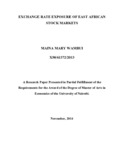Exchange rate exposure of east African stock markets
| dc.contributor.author | Maina, Mary W | |
| dc.date.accessioned | 2014-12-04T07:00:27Z | |
| dc.date.available | 2014-12-04T07:00:27Z | |
| dc.date.issued | 2014-11 | |
| dc.identifier.uri | http://hdl.handle.net/11295/76243 | |
| dc.description.abstract | The study examines the exchange rate exposure of East African stock markets. It aimed at identifying whether the stock markets are exposed to changes and volatility of US$ exchange rate and through which mechanisms does this exposure occur. The study considered three stock markets in East Africa during the period January 2009 to April 2014 using Arbitrage Pricing Theory (APT) and panel data estimation techniques. The unexpected factors were obtained using Autoregressive Integrated Moving Averages (ARIMA) and volatility was estimated by GARCH (1,1) model. The results reveal that the stock markets are exposed positively to unexpected US$ exchange rate changes and negatively to the volatility of exchange rate. Moreover, a deeper financial market and a less open economy reduce exchange rate exposure. Hence in formulation of monetary policies exchange rate should be put into consideration and also policies that promotes financial markets should be encouraged. | en_US |
| dc.language.iso | en | en_US |
| dc.publisher | University of Nairobi | en_US |
| dc.title | Exchange rate exposure of east African stock markets | en_US |
| dc.type | Thesis | en_US |
| dc.type.material | en_US | en_US |

